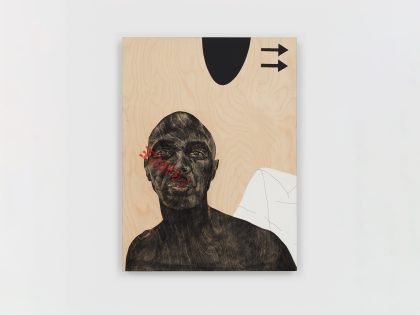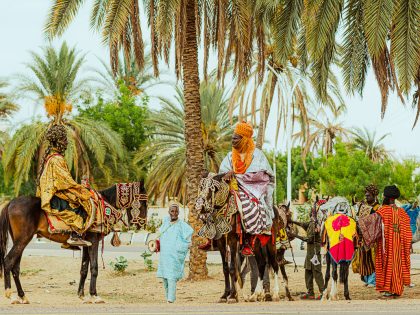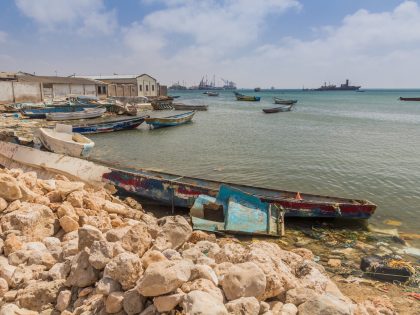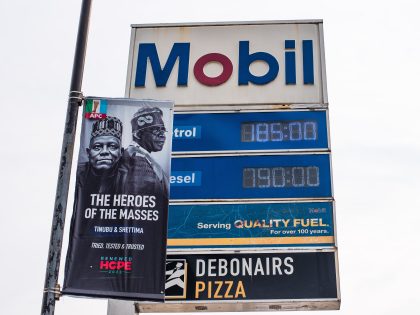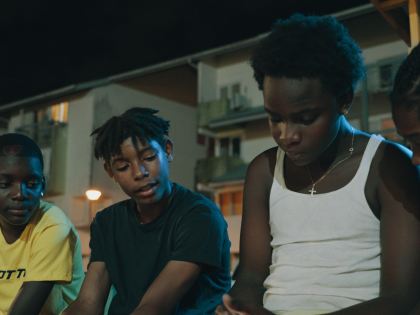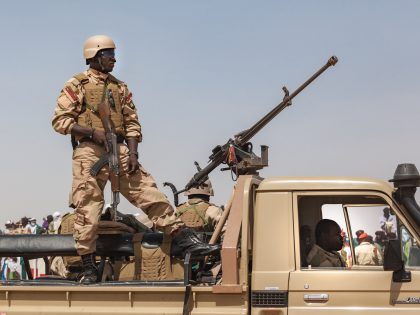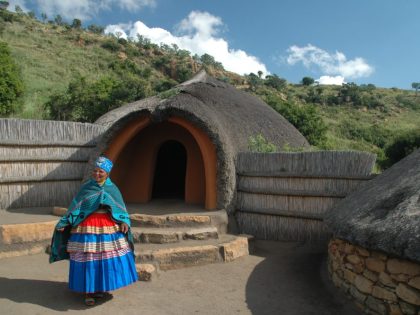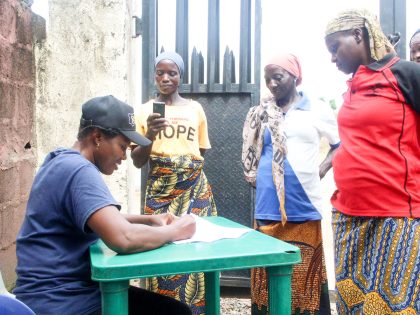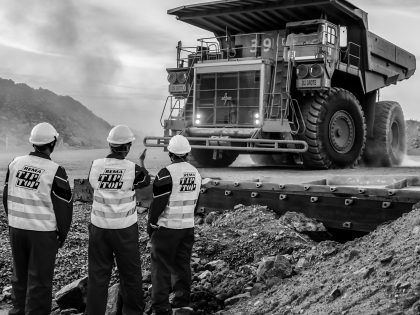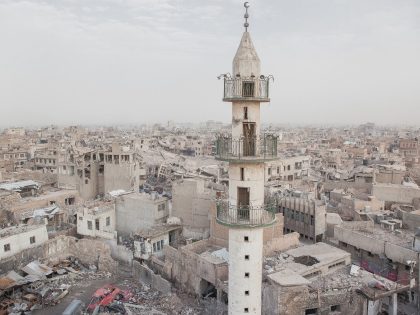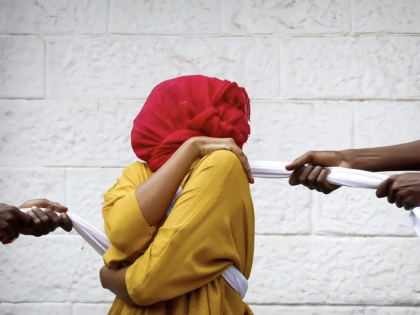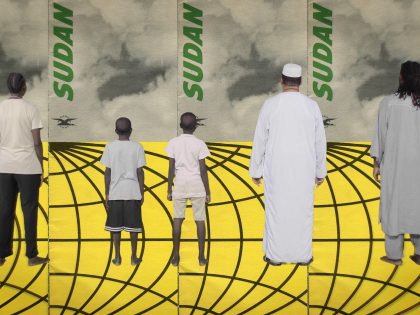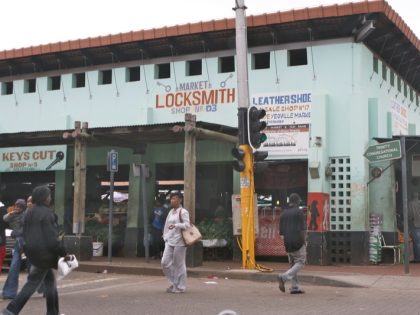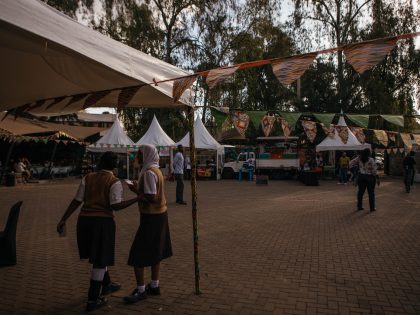The art of unrest
Cape Town artists, Hasan and Husain Essop, tackle the struggle for land, adequate housing, education and equality in South Africa in their work.

Standard Bank Young Artists for Visual Arts Hasan & Husain Essop.
The Cape Town-born twin brothers Hasan and Husain Essop move beyond the expected. They play with fixed notions of place and identity as well as preconceptions of religion and tradition in a city that values keeping its apartheid era categories, especially for those it labelled its picturesque, acquiescent others: the Muslims who are the descendants of the first wave of dissenters and slaves brought to the Cape from Indian Ocean islands by the Dutch East India Company. Born in 1985 in Cape Town, both studied at Michaelis School of Fine Art and started to work together on the Halaal Art project shortly after their graduation. After Halaal Art, the young artists went through an artistic and personal journey to other projects, notably Remembrance to Unrest. Besides working and developing their art, both have teaching degrees and work as arts facilitators in the community of Hangberg and Imizamo Yethu in Hout Bay, communities shaped by poverty and threatened by or outright faced with forced removals. Shaped by their experiences, and using the concept of spaces and places in the city, the twins reflect on the unrest happening in South Africa and all over the world. The subsequent project, Unrest, will be on show at the Standard Bank Gallery in Johannesburg from the 22st of April until the 20st of June. Unrest responds to the waves of xenophobic violence, as well as the struggle for land, adequate housing, education and equality in South Africa.
This past April, I spoke to Hasan and Husain in Hout Bay, Cape Town.
Cornelia Knoll: Remembrance showed work that you did while you traveling, Unrest brings it back to Cape Town in a way. Did you work on this series of photographs specifically for the Standard Bank Prize and what inspired it, what was the first spark?
Hasan: You know with Remembrance we were looking at the narrative and the history of Islam and the historical locations and landscapes that represent the religion. I think with Unrest when we received the award with Standard Bank it was such an honour and a privilege. More so that it is a South African Award, we felt a comfort, you know, proudly South African, as it is an award only given to South Africans. For us the context was that we wanted to bring our work back into South Africa and specifically Cape Town. They look at your career and at what you’ve done over the years. I don’t think it is a particular body that makes you win the award. I think its what you’ve done and contributed. We looked at the beginning of where our work started, which was obviously Cape Town, and the different societies, communities and different narratives within the city. Doing a start in Cape Town, a round-trip, it felt right to come back home..
I hope like in the future that I do something different and we will explore different ways of creating work, so the show was definitely not a conclusion but a kind of summary of all the narratives that we created, at the same time, showing the climax of our technique and method.
Husain: Well, to win the Standard Bank prize was absolutely amazing, like Hasan said, you accept it as an South African Artist. More importantly it was a platform for us to create a new body. Giving us the financial backing, the support, the confidence to really push ourselves to create a new body. It was exciting, its always exciting to go back to the drawing board and to try and push yourself to create something new that attracts attention, cause you also have the pressure to produce a body of work that can either make or break you. But I think we pulled through really nicely, I think Cape Town is the best place to start or to create this body of work, keeping, staying truthful to our technique. It is also a nice stage to explore sculpture, to explore installations and to push our video elements so it gave the viewer a nice full body experience so to say where it satisfied the appetite of the eyes, the ears as well as the hands.
CK: How does the video art speak to the photographs? Can you explain a bit what the video art is about?
Husain: The way the video work relates to the photographs, very interesting question, it was actually made in conjunction with the installation that was made talking about Ashura, or self- flagellation, the Shi’a on a specific day they celebrate Ashura in order to shed blood the death of a famous Imam, Imam Husain, and we intended to initially create the videos to show the viewer or justify why we put together this installation. How these weapons are actually used to self-flagellate your self but kind of this video stood on its own. We cropped out our heads and the first represents the chest beating which is the first process of the celebration and then goes into a more advanced process where they start chain-whipping their backs. We wanted to portrait these two videos so that the viewer could see visually in a movement process how these weapons are actually used on the body.
CK: How do people from the Muslim community respond to your work? Because I know you where saying that you didn’t grow up with photographs and pictures in your family home, meaning that images are actually something you don’t really show, yet you do explore these things and bring it to an open public. What is the thought behind it?
Hasan: I think the small Muslim art community that does exist were quiet impressed and very supportive that Husain and I managed to create another form of Muslim art. I think for many years Muslim or Islamic art has just been identified as calligraphy or things that are non-figurative. Were Husain and I really opened another avenue. I think this is also a route to our success because we’ve managed to corporate our beliefs into our art. At the same time there is also a lot of misunderstanding within the Muslim community. In the larger population, the larger Islamic group, there is no history of art within the family, the way they were brought up and there is still a lot of awareness and kind of education that needs to be done. A lot of people don’t understand it, so it is more ignorance than other things that upset them… I believe. I think if people have some sort of backing or knowledge they really connect with the work and our intention. All in all it has been more positive than negative.
CK: I am interested to hear more about the motivation behind your work. You speak about the Cape Malay ancestors, the history of the City, the Imams of Cape Town — just to give few examples — is this also because the community has previously not been seen or prevented from being seen? That you are now able to represent something that has never been shown?
Husain: That is a very interesting statement. Yes, for sure. I agree, totally. In the past people went through their own struggle and their mind was occupied by what is happening around them. You had a lot of photographers that documented it and today they still selling their work cause it represents a certain time, an oppressed time. They became really successful and built their careers at that time. History has created lots of subject matter for us to explore, it is always good to revisit your own history and learn from your mistakes, so to say. We also find ourselves history repeating itself, which is a very interesting concept. Especially today, how it is repeating itself and the same hurt and pain is inflicted on different nations. It is our food for our thoughts and we try to capture history but also capture present day. Cause, present day becomes history so to say. What happens, what we see growing up, what we see around us. What we see and experience within our communities, just try to re-enact that. Sometimes we also see ourselves a bit humorous, we recreate these scenes that don’t really exist, but what if it existed. Or maybe it does exist in another land, so we try to be a bit comical there. Humour being a good way to get the viewers thoughts.
Hasan: We come from a secular society that for many years has kind of been somewhat secretive about what they do. Be it the Muslim community, the Malay, Indian, being in the art world or showing things that happens in their home or traditions was never really documented. So I think now, more recently you have these traditions that have been passed on for generations, being represented and presented to people that have never been able to see it. So I agree with you, we are presenting these stories that have been around for many many years, for generations, in our photographs and people are now..providing our window, our view, our perception of the things, our story or our interpretation of it and you know sometimes its accurate sometimes its not. Hm, but with these …speaking about slavery, speaking about the people that came through slavery, speaking about Malay/ Indian culture, traditions, religions, the difference between religion and tradition. Some of the politics within the Islamic world, I think its all relevant issues being discussed.
CK: When I went to see the exhibition at the National Gallery in Cape Town, the first photograph that I looked at was Resurrection and it really struck me. It shows the vacant land of District Six, bodies spread on the desolated land. Could you speak a bit about the picture? What do the colours and the cloth represent?
Husain: For sure, the photograph is quiet a nice memory. Hasan and I fought quiet a lot on scene and the outcome as you can see was actually quiet amazing. The light was perfect, the symbolism of the cloth the fabric used for the Kaapse Klopse. My father supplies the fabric to them and we basically used their colours and laid it on the ground. The same way you would lay over a persons grave. You won’t really erect any sculptures or statues. You basically cover the grave with a piece of cloth to identify where the body is buried so that you don’t tramp on that ground or tramp on the body out of respect. These cloths are laid as graves to signify the people that lived there, that they were forcibly removed from their homes. The land is basically a graveyard to us because the people lived there and you know, these cloths represent these homes which was for us, kind of life itself. It was the only place here in Cape Town where people from different race groups lived together harmoniously. Resurrection also deals with the idea of being resurrected. So the way resurrection is described in the Holy Quran is that people will rise from nothing, it will rain this drop of semen so to say and once it hits the ground your little bone, your body will basically merge from this little bone. And from nothing you will rise up into something. You can see in the cloths, there is actually the stages of nothing and then the body starts to emerge and you have these people rising up and walking like Zombies. And that is the way it is described, the day of Judgement. People won’t really know that its judgement day, only afterwards they realise that they have been resurrected. So the same kind of metaphor of people being resurrected, District Six being resurrected. Bringing back people who once lived in District Six coming back to their homes. But in that also there are issues where a lot of them have passed on, now it is their siblings that inheriting the land and that is breaking up family groups because people are now fighting over the properties. It is quiet interesting that there is unrest even in something so positive.
CK: Is this also how the title of the exhibition came up?
Husain: The title was quiet interesting as Hasan and me had weeks and weeks of arguments of what the title is gonna be. Hasan was fixed on the idea, the title unrest. He sold it to me by saying:’ you know what, its quiet a contradictory word as it has the word rest in it, yet it deals with something where you are uneasy, unsure, where your body is in a state of unrest. And we found it a very fitting title because we live in the state as South Africans, we live in the state of unrest. Being overcome by violence, by crime, by drug abuse, also where we work, we are surrounded by this, we experience this, and we felt that it fitted the body of work and it fits the time frame we are living in you know. If we should look back in 20 years time, we can say that it was a period of Unrest. The Unrest that is happening in Syria, Lebanon, Palestine, you know, within the Muslim world there is this constant experience of unrest amongst Muslim people.
CK: Where do you see the role, the power of your art in that time? Times of unrest?
Husain: I feel Unrest is just the beginning of something, there is a lot of potential to speak about. And I am hoping we can achieve photographs that really capture more of this unrest that is really been experienced, within Nigeria, within Palestine, you know, I feel that the works slowly captures it, slowly captures our experience, and our effect. How crime has effected us, how we trying to deal with it, how we internalising it. But I feel like there are more photographs that are needed to really complete the body of work.
CK: I see a lot of shadows, looking at Mandela Park and 786. Can they be interpreted as ‘shadows of the past’? What do these shadows represent?
Husain: That’s beautiful, shadows are the reflection of the past, and that is exactly what those shadows represent in these photographs. Specifically with 786 where these photographs represent these dark entities that once existed within this special location. These dark entities, that sell drugs to youngsters, that operate with breaking into homes, etc etc. und you can see some of the shadows are emerging from urine, from dirt, highlighting that these are dark shadows, these are not good shadows. Some of these shadows don’t correspond with the people there, talking about, they basically symbolising different poses, like reaching in the back of their pants for a gun, maybe, creeping up as if you break into somebody’s car, somebody’s home. Those are what the shadows really relate to.
In comparison to Mandela Park, those shadows talk about the unrest that these communities are experiencing with regard to sanitation, housing etc. all the protest action that has been happening. So you have these ideal men, however the shadows are not idle, they are in the state of protest.
CK: Did you take these pictures while you were working with a specific community in another capacity than as artists producing work towards a project? What inspired you at the Lalela Arts Project in Hangberg and Imizamo Yethu, Hout Bay, where you were working with youth living under these circumstances about which we have been speaking?
Husain: Yes, for sure. That specific shot Mandela Park was inspired by the youth we are working with, where they live, cause this is where they come from. This is what they experiencing. Our reasons for working with Lalela, is to work with youth that are effected by domestic violence. That specific shot we had some of our students accompanying us. It was quiet nice that they were accompanying us, so it felt really safe doing it. It was also a way of us showing them how we work, with which method we working and I knew that once it was printed and framed, exhibited and shown in a magazine, I could take it back to my students and show them with pride: ‘ look here, you are part of this.’ That is what I really wanted to achieve with that.
The other location however is out of the community where we are working in, so we have a really good friend that helps us and he accompanies us with a lot of the shots. He comes from quiet a rough community in Athlone and a lot of our inspiration does come from him and our conversations with him. Those shots where kind of inspired though his interactions with us and he has been there since the beginning, so he has moulded us quiet a bit and moulded the work as well.
CK: You’ve always produced and exhibited work together. What is your typical way of working together: As you mentioned before, there is conflict. I think it must be quiet a challenge to work as a team, as twins, sometimes. Do you see it changing over the years, or are you in a routine by now?
Husain: Nah, for me, its because of that friction that we can create work. Hm…
CK: Does creativity come out of this friction?
Husain: Definitely creativity and …we are always arguing. I do hope we reach a point where we can work a bit better with each other, understand each other and keep and open mind. We both are very bull-headed.
Hasan: Its not that, it is just that, in art you have…in a work you are trying to, for example, send a message. You have a statement you want to make. The problem comes when the statement differs. When he wants to say something, I want to say something and its different and you only have this one picture to say it. I think that is where the arguments come when you try to say too much or you try to say too little. That is the tricky part. But you see when you have a location and everything goes the way you wanted, you have the perfect props with you, you have a perfect day, the perfect light. No one is messing with you on the location, everything works out. You see with that for me, that just runs smoothly. Where as with photographs where you not really prepared, things are not right, you get some issues on the day, and you try to make something out of it, that is where we sometimes have problems. Its just what you’ve working with.
CK: And are these pictures that are the ones that are the most powerful ones?
Hasan: Sometimes you know, it happens, where it is the luck of the draw.
Husain: Yes, definitely, that is my process, I am like, lets go out without any planning and shooting and see what happens and let the magic take over. Where Hasan is more like, no you need to plan and exactly know what you going to do on site. You know that is where we at log heads with each other, because I don’t like working like that, I agree with a certain amount of planning but I know, if you, if you plan, plan, plan and you don’t become productive, then what is the point of planning. My thing is to go out there and shoot, even if you not going use the work, just keep yourself warmed up. You can’t expect to draw like a professional if you don’t draw for five years, in that time you need to keep your hand warm. That is what I feel like, just go out and shoot, keep your hand warm, keep your eye warm, so when you do have these shots that you plan so carefully for, that you ready for it. That you don’t, you not unfit, so to say, and because you are so out of production, you don’t pull it off the way you expect it to pull it off. When you remaining productive and practical you doing four shots a day, because you so warmed up, to do so. So that’s where we fight quiet a bit, yes.
CK: Masculinity is always present in your work. Do you have plans to explore the feminine side? The role of women within the community, in Islam, etcetera?
Husain: We respond to this question by saying we are not women and its very difficult for us to represent a female side of Islam. Different women will differ in their interpretations of Islam, some might feel oppressed, some might feel in charge of themselves. We do feel that Islam is fair to both sexes. Hasan had his opportunity to dress like a lady, I had my opportunity to dress as a lady, we do try to portrait it but not in the light way, where we are actually being the voice for women, I think this is an interesting step forward. I know Hasan is exploring something with his new work, speaking about women, very interesting, so yes, this is something that we are keeping for future works.








